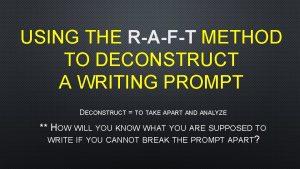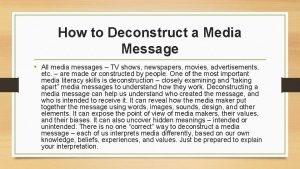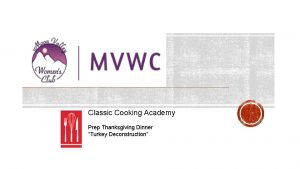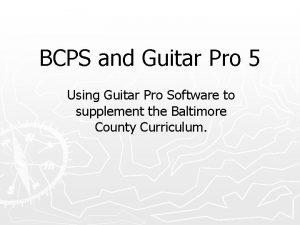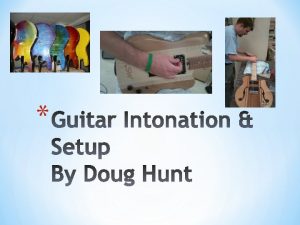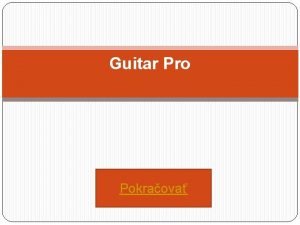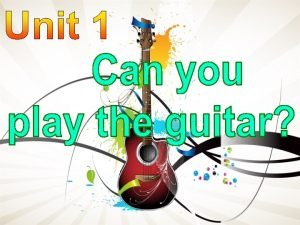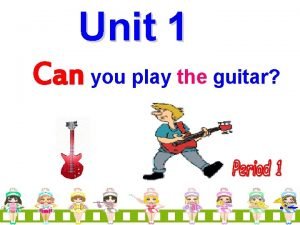The Guitar Deconstruct and Design 1 Question Research






- Slides: 6

The Guitar: Deconstruct and Design 1. Question & Research Task SLIDE NAVIGATION 1 2 3 4 Guitar-like instruments have existed for centuries. Historians have identified images resembling guitars in carvings dating back more than 3000 years, but the origins of the modern guitar began taking shape in medieval Spain. Despite its long history, the guitar’s golden age didn’t begin until the 20 th century. Throughout the 20 th century and continuing today, the guitar has found a role in many musical genres. The guitar’s popularity and versatility is largely made possible by its dynamic design capabilities. Changing components and/or its blueprint can produce a range of sounds. As you prepare to research, think about your musical taste: What’s your favorite musical genre? How do artists typically use guitars in this genre? What kind of guitar sounds do you enjoy? Image Source: Discovery Education For this Slam Dunk, you will be learning more about how the guitar’s design influences its sound so that you can design a signature guitar. In this Slam Dunk, you will conduct brief, focused research to respond to the inquiry question: How do a guitar’s components and anatomy influence its sound? 5 6 Next

SLIDE NAVIGATION 2. Information Sources 1 2 3 4 5 6 Choose several of the information sources linked here to complete the Student Activity on Slide 3. Strings and frets Acoustic Styles Guitar String types Cutaway vs non-cutaway Cutaway: advantages and disadvantages Cutaway or non-cutaway Tonewood sounds Tonewood and New Materials Eco-friendly woods Martin Tonewoods Body style Electric Guitar body Body Types PRS Construction Comparing guitar body types Body styles defined Pickups Science of Sound Guitar pickups explained Types of pickups Design/accessories Design examples Guitar inlays Custom inlays Multi-neck guitars Guitar headstock Types of headstocks Body Shape Electric guitar body types Electric guitar types Amplifier overview Amplifier terminology Amplifier buying guide Acoustic-Electric Acoustic-electric: how they work Pros/Cons of acoustic-electric Pedal Guitar pedal basics Essential pedals Guitar pedal essentials Guitar accessories for beginners Image source: Discovery Education *If you are prompted to log in to access a database or digital content links, your teacher/librarian can provide login information. Next

SLIDE NAVIGATION 3. Student Activity 1 2 3 4 5 6 Next Use the information sources on Slide 2 to identify the parts of the guitar and how the parts impact the sound of the instrument. For each guitar component OR component(s) assigned by your teacher, you will use as many linked resources* as needed to complete the graphic organizer. When taking notes, be sure to Identify the type(s) of guitar that use this component Define the key terms Describe common uses and impact on sound Record notes on what type of each component appeal to your musical interest *If you are prompted to log in to access a database or digital content links, your teacher/librarian can provide login information. Click on the image above to access the graphic organizer. Notetaking Tips Since some sources are longer, consider skim and scan techniques to help you find the information you need faster. “Find” is a useful tool when looking for key terms. Just select ctrl + f on your keyboard and type in the term to search the page to quickly find mentions on the page.

4. Assessment Activity SLIDE NAVIGATION 1 2 3 4 5 How do a guitar’s components and anatomy influence its sound? Many musical artists have created their own special, customized “signature” guitars that they take on tour year after year. Your job is to design your own signature guitar and to be able to provide reasons for your choices. Be sure to include the guitar type, body style, choice of wood, guitar shape or cutaway, string types or pickup style, and color scheme/pattern/paint job. 1. PLAN: Read the prompt above carefully and become familiar with the Success Criteria. 2. BRAINSTORM: Use your design ideas notes and/ or this planning sheet to begin thinking about your signature guitar choices. 3. CREATE! Using one of the tools below, paper, template, or other teacher recommended tool, design your signature guitar including the elements identified in your notetaker. Google Drawings (can be accessed using https: //docs. google. com/drawings/) Wixie (Can be accesses in the Apps Portal) 4. REFLECT: In a short essay, brief video recording format selected by your teacher, reflect on your choices by responding to at least two of the following questions: What considerations went into designing your “signature” guitar? Why did you decide on your chosen features? How does your guitar design reflect your own personal taste in music? 5. EVALUATE: Check your work against the Success Criteria. Image source: Wikimedia Commons 6 Next

5. Enrichment Activities SLIDE NAVIGATION 1 2 3 4 5 6 Next Now that you have the blueprint of your design, it’s time to take the next steps towards creating your masterpiece. WATCH In this video Queen’s guitarist Brian May describes building his famous “Red Special Guitar. ” THINK ABOUT What unique feature would you add to your signature guitar? LEARN Watch this video on how to build a guitar. You may also want to check out How To Build An Amazing Guitar With Scrap Wood or How to Build an Electric Guitar From Scratch. Click on the image above to see a Discovery Education video on building a guitar Image Source: Discovery Education DRAFT Using your blueprint and what you’ve learned about building a guitar, make a list of the parts you will need to build your custom guitar.

6. Teacher Resources Learning Standards Alignment Content Learning Standards MU: Cn 10. 0. H. 8 a Demonstrate how interests, knowledge and skills relate to personal choices and intent when creating, performing, and responding to music. MU: Re 7. 2. H. 8 a Describe how the way that the elements of music are manipulated and knowledge of the context (social and cultural) influence the response. Common Core State Standards for English Language Arts & Literacy Reading: 1. Read closely to determine what the text says explicitly and to make logical inferences from it; cite specific textual evidence when writing or speaking to support conclusions drawn from the text. Writing: 7. Conduct short as well as more sustained research projects based on focused questions, demonstrating understanding of the subject under investigation. AASL Standards Framework for Learners - Inquire: Build new knowledge by inquiring, thinking critically, identifying problems, and developing strategies for solving problems. Think: Learners display curiosity and initiative by: I. A. 2 Recalling prior and background knowledge as context for new meaning. Create: Learners engage with new knowledge by following a process that includes: I. B. 1 Using evidence to investigate questions. I. B. 3 Generating products that illustrate learning. Share: Learners adapt, communicate, and exchange learning products with others in a cycle that includes: I. C. 1 Interacting with content presented by others. Grow: Learners participate in an ongoing inquiry-based process by: I. D. 2 Engaging in sustained inquiry. ISTE Standards for Students: 3. Knowledge Constructor – 3 d. Students build knowledge by actively exploring real-world issues and problems, developing ideas and theories and pursuing answers and solutions. SLIDE NAVIGATION 1 2 3 4 5 6 Grade 8 Content Area: Music/Guitar Objective: Time Frame: 2 -3 class periods of 50 minutes each Notes to the teacher: Collaborate with your school library media specialist to plan and implement this lesson. Have students use learning supports provided in any BCPS-licensed Digital Content included in this lesson. Refer to Digital Content Snapshots & Support resources for guidance as needed. Consider using the Schoology Assignment Apps feature to assign Microsoft and Google documents and files for students to access, edit, and submit through Schoology. The note-taker may be assigned individually, pairs, or small groups. Notes could be shared in a jigsaw, poster presentation, etc. Flipgrid, Voice. Thread, or Schoology Assessments can be used for the assessment recording. Access recording app in the Apps Portal. Last updated: July 2021 Report broken links to BCPS Library Media Programs & Digital Resources 443 -809 -4035 BCPS Slam Dunk Research Model, Copyright 2020, Baltimore County Public Schools, MD, all rights reserved. This lesson may be used for educational, non-profit school use only. All other uses, transmissions, and duplications are prohibited unless permission is granted expressly. This lesson is based on. Dr. Jamie Mc. Kenzie’s Slam Dunk Digital Lesson model.
